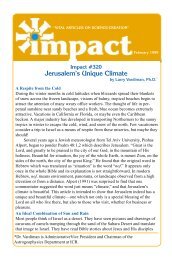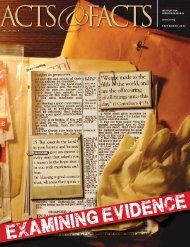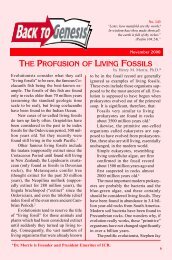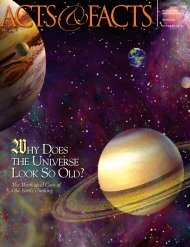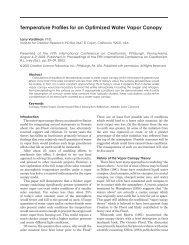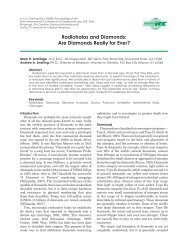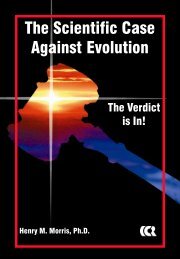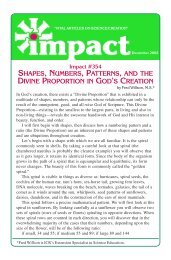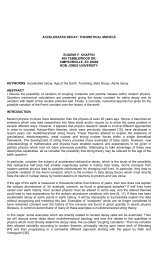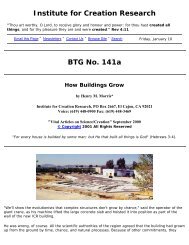The petrogenetic model <strong>the</strong>re<strong>for</strong>e favored by Gamble et al. [5], which is consistent with all <strong>the</strong> isotopicdata discussed in Snelling [18], <strong>and</strong> shown in Fig. 6, is based on Tatsumi [23] <strong>and</strong> Davies <strong>and</strong>Stevenson [4]. This model envis<strong>age</strong>s a zone <strong>of</strong> melt <strong>for</strong>mation approximately coincident to <strong>the</strong> volcanicfront, which includes Ruapehu <strong>and</strong> Ngauruhoe, <strong>and</strong> a melt generation region delimited by <strong>the</strong> interface<strong>of</strong> <strong>the</strong> subducting slab, <strong>the</strong> base <strong>of</strong> <strong>the</strong> arc lithosphere (<strong>of</strong> continental New Zeal<strong>and</strong>) <strong>and</strong> two verticalcolumns, one delineating <strong>the</strong> volcanic front, <strong>the</strong> o<strong>the</strong>r, <strong>the</strong> coupled back-arc basin. Fluids liberated from<strong>the</strong> descending slab ascend into <strong>and</strong> enrich <strong>the</strong> overlying periodite down to higher pressures, where <strong>the</strong>amphibole breaks down giving rise to amphibole dehydration, while progressive dehydration reactions in<strong>the</strong> slab itself lead to fluid transfer from <strong>the</strong> slab into <strong>the</strong> mantle wedge, both processes producing partialmelting as amphibole breaks down over <strong>the</strong> depth range 112±19 km as discussed by Tatsumi [23] <strong>and</strong>Davies <strong>and</strong> Stevenson [4]. The lower density melt <strong>the</strong>n rises <strong>and</strong> pools in <strong>the</strong> upwelling melt column,eventually penetrating upwards into <strong>the</strong> overlying arc lithosphere to fill magma chambers that <strong>the</strong>n eruptwhen full.The Rb-Sr, Sm-Nd, <strong>and</strong> Pb-Pb radioisotopic ratios in <strong>the</strong> samples <strong>of</strong> this study <strong>of</strong> recent (1949-1975)<strong>and</strong>esite lava flows at Mt. Ngauruhoe, New Zeal<strong>and</strong>, as anticipated, do not yield any meaningful <strong>age</strong>in<strong>for</strong>mation, even by selective manipulation <strong>of</strong> <strong>the</strong> data. Instead, <strong>the</strong>se data provide evidence <strong>of</strong> <strong>the</strong>mantle source, <strong>of</strong> magma genesis, <strong>and</strong> <strong>of</strong> <strong>the</strong> crustal contamination <strong>of</strong> <strong>the</strong> parental basalt magmas. Byimplication, <strong>the</strong> radioisotopic ratios in ancient lavas found throughout <strong>the</strong> geologic record must similarlyexpress <strong>the</strong> fundamental characteristics <strong>of</strong> <strong>the</strong>ir geochemistry. They <strong>the</strong>re<strong>for</strong>e must also strongly reflect<strong>the</strong> magmatic origin <strong>of</strong> <strong>the</strong> lavas from mantle <strong>and</strong> crustal sources <strong>and</strong> any history <strong>of</strong> mixing orcontamination in <strong>the</strong>ir petrogenesis which can dramatically distort any inferred isotopic <strong>age</strong>. Eventhough radioisotopic decay has undoubtedly occurred during <strong>the</strong> <strong>earth</strong>’s history, conventionalradioisotopic dating <strong>of</strong> <strong>the</strong>se rocks <strong>the</strong>re<strong>for</strong>e cannot provide valid absolute <strong>age</strong>s <strong>for</strong> <strong>the</strong>m. This isespecially so if accelerated nuclear decay accompanied <strong>the</strong> catastrophic geologic <strong>and</strong> tectonicprocesses responsible <strong>for</strong> <strong>the</strong> mixing <strong>of</strong> <strong>the</strong> radioisotopic decay products during magma genesis.Fifteen rock samples have also been collected from <strong>the</strong> Somerset Dam gabbro intrusion near Brisbane,Australia [19], probably a well-preserved, unmetamorphosed subvolcanic magma chamber. Thesamples were processed <strong>and</strong> submitted to various laboratories <strong>for</strong> whole-rock major <strong>and</strong> trace elementanalyses <strong>and</strong> <strong>for</strong> K-Ar, Rb-Sr, Sm-Nd, <strong>and</strong> Pb-Pb radioisotopic analyses. Additionally, one <strong>of</strong> <strong>the</strong> gabbrosamples from one <strong>of</strong> <strong>the</strong> cyclic units was separated into its mineral constituents using heavy liquids, <strong>and</strong><strong>the</strong> resultant plagioclase, augite, olivine, <strong>and</strong> magnetite-ilmenite concentrates, along with a duplicatepiece <strong>of</strong> <strong>the</strong> whole-rock, submitted <strong>for</strong> K-Ar, Rb-Sr, Sm-Nd, <strong>and</strong> Pb-Pb radioisotopic analyses.Figure 6. Petrogenetic model <strong>of</strong> melt <strong>for</strong>mation near a subducting slab, based on Tatsumi [23] <strong>and</strong>Davies <strong>and</strong> Stevenson [4]. Mixing <strong>and</strong> inheritance <strong>of</strong> <strong>radioisotopes</strong> invalidate conventional <strong>age</strong> dating.
The objective <strong>of</strong> this study was not only to compare <strong>the</strong> different dating methods, but also to comparewhole-rock <strong>and</strong> mineral isochron <strong>age</strong>s <strong>and</strong> to test whe<strong>the</strong>r <strong>the</strong>re are variations in <strong>the</strong> <strong>radioisotopes</strong>between <strong>the</strong> cyclic units, <strong>and</strong> between <strong>the</strong> macrolayers within <strong>the</strong>m. From <strong>the</strong>se studies it may bepossible to infer how mixing occurs in a magma chamber <strong>and</strong> demonstrate that radioisotopiccompositions <strong>of</strong> crustal rock may reflect characteristics <strong>of</strong> <strong>the</strong> magma sources in <strong>the</strong> mantle ra<strong>the</strong>r than<strong>the</strong> <strong>age</strong>s <strong>of</strong> <strong>the</strong> intrusion.Significant Amounts <strong>of</strong> 14 C in Deep Strata – Dr. John R. Baumgardner, PIAccording to <strong>the</strong> conventional geologic time-scale, organic materials older than about 250,000 yearsshould be utterly 14 C “dead”. This is because <strong>the</strong> half-life <strong>of</strong> 14 C, only 5730 years, is so short. 250,000years <strong>of</strong> decay (corresponding to 43.6 half-lives) reduces <strong>the</strong> number <strong>of</strong> initial 14 C atoms by a factor <strong>of</strong> 7x 10 -14 . A gram <strong>of</strong> modern carbon contains about 6 x 10 10 14 C atoms, so not a single 14 C atom shouldremain after 250,000 years. The astonishing result, however, is that, almost without exception, whentested by accelerator mass spectrometer (AMS) methods, organic samples from every portion <strong>of</strong> <strong>the</strong>Phanerozoic record show detectable <strong>and</strong> reproducible amounts <strong>of</strong> 14 C! This reality has beenestablished as dozens <strong>of</strong> AMS laboratories around <strong>the</strong> world over <strong>the</strong> last 20 years have soughtdesperately to underst<strong>and</strong> why organic samples from deep within <strong>the</strong> geological record, thought to betens to hundreds <strong>of</strong> millions <strong>of</strong> years old, should consistently contain 0.1-0.5 percent <strong>of</strong> <strong>the</strong> modern level<strong>of</strong> 14 C. Believing this 14 C had to be contamination, <strong>the</strong>y have mounted an intense quest to identify <strong>and</strong>eliminate sources <strong>of</strong> contamination in <strong>the</strong>ir AMS procedures. But despite improvements in techniques,this level <strong>of</strong> 14 C, on <strong>the</strong> order <strong>of</strong> 0.1-0.5 percent modern carbon (pmc), continues to be reported <strong>for</strong>samples that, given <strong>the</strong>ir location in <strong>the</strong> geological record, should be entirely 14 C “dead”. Many scores<strong>of</strong> such measurements are readily available in <strong>the</strong> st<strong>and</strong>ard peer-reviewed radiocarbon literature asdocumented by Giem [7] <strong>and</strong> Baumgardner et al. [1] <strong>and</strong> displayed in Fig. 7. Measurable 14 C at roughlyuni<strong>for</strong>m values in pre-Flood organic materials fossilized in Flood strata, <strong>of</strong> course, represents powerfulsupport <strong>for</strong> <strong>the</strong> young <strong>earth</strong> <strong>Creation</strong>-Flood model.Number <strong>of</strong> Samples10864214 C/C Ratios Measuredin BiologicalPhanerozoic SamplesMean: 0.292Std dev: 0.16200 0.1 0.2 0.3 0.4 0.5 0.6 0.7Percent Modern CarbonFigure 7. Distribution <strong>of</strong> 14 C values <strong>for</strong> biogenic samples from <strong>the</strong> radiocarbon literature. Given <strong>the</strong>irposition in <strong>the</strong> geological record, all <strong>the</strong>se samples should contain no detectable 14 C according to <strong>the</strong>conventional geological time scale.Aware <strong>of</strong> this, Snelling [10,11,13,14,15] analyzed <strong>the</strong> 14 C content <strong>of</strong> fossilized wood conventionallyregarded as 14 C “dead” because it was derived from Tertiary, Mesozoic, <strong>and</strong> upper Paleozoic stratahaving conventional <strong>age</strong>s <strong>of</strong> 40 to 250 million years. All samples were analyzed using AMS technologyby a reputable commercial laboratory, with some duplicate samples also tested by a specialist laboratoryin a major research institute. Measurable 14 C well above background was obtained in all cases.More recently, as a check on <strong>the</strong> AMS results in <strong>the</strong> peer-reviewed literature, <strong>the</strong> RATE team acquired asuite <strong>of</strong> ten coal samples from <strong>the</strong> U.S. Department <strong>of</strong> Energy Coal Repository. These samplesrepresent important U.S. coal deposits <strong>and</strong> span <strong>the</strong> geological record from Carboniferous to Eocene.The 14 C measurements by one <strong>of</strong> <strong>the</strong> best AMS laboratories in <strong>the</strong> world <strong>for</strong> <strong>the</strong>se ten samples aredisplayed in graphical <strong>for</strong>m in Fig. 8 <strong>and</strong> discussed in Baumgardner et al. [1]. The 14 C levels <strong>for</strong> <strong>the</strong>sesamples fall nicely within <strong>the</strong> range <strong>of</strong> values shown in Fig. 7. We conclude that <strong>the</strong> well documentedevidence <strong>of</strong> 14 C in fossil organic material provides compelling support <strong>for</strong> <strong>the</strong> young <strong>earth</strong> <strong>Creation</strong>-Floodmodel <strong>and</strong> represents a severe challenge <strong>for</strong> <strong>the</strong> uni<strong>for</strong>mitarian assumptions underlying <strong>the</strong> long half-liferadioisotope methods.



